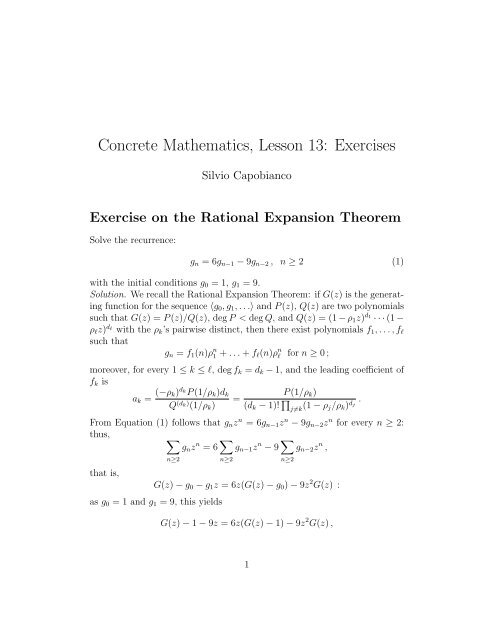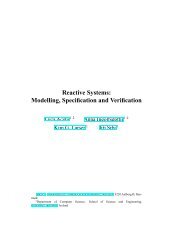Concrete Mathematics, Lesson 13: Exercises - Cs.ioc.ee
Concrete Mathematics, Lesson 13: Exercises - Cs.ioc.ee
Concrete Mathematics, Lesson 13: Exercises - Cs.ioc.ee
You also want an ePaper? Increase the reach of your titles
YUMPU automatically turns print PDFs into web optimized ePapers that Google loves.
<strong>Concrete</strong> <strong>Mathematics</strong>, <strong>Lesson</strong> <strong>13</strong>: <strong>Exercises</strong><br />
Silvio Capobianco<br />
Exercise on the Rational Expansion Theorem<br />
Solve the recurrence:<br />
gn = 6gn−1 − 9gn−2 , n ≥ 2 (1)<br />
with the initial conditions g0 = 1, g1 = 9.<br />
Solution. We recall the Rational Expansion Theorem: if G(z) is the generating<br />
function for the sequence 〈g0, g1, . . .〉 and P (z), Q(z) are two polynomials<br />
such that G(z) = P (z)/Q(z), deg P < deg Q, and Q(z) = (1 − ρ1z) d1 · · · (1 −<br />
ρℓz) dℓ with the ρk’s pairwise distinct, then there exist polynomials f1, . . . , fℓ<br />
such that<br />
gn = f1(n)ρ n 1 + . . . + fℓ(n)ρ n ℓ for n ≥ 0 ;<br />
moreover, for every 1 ≤ k ≤ ℓ, deg fk = dk − 1, and the leading coefficient of<br />
fk is<br />
ak = (−ρk) dkP (1/ρk)dk<br />
Q (dk) (1/ρk)<br />
=<br />
P (1/ρk)<br />
(dk − 1)! <br />
. dj<br />
j=k (1 − ρj/ρk)<br />
From Equation (1) follows that gnzn = 6gn−1zn − 9gn−2zn for every n ≥ 2:<br />
thus, <br />
gnz n = 6 <br />
gn−1z n − 9 <br />
gn−2z n ,<br />
that is,<br />
n≥2<br />
n≥2<br />
n≥2<br />
G(z) − g0 − g1z = 6z(G(z) − g0) − 9z 2 G(z) :<br />
as g0 = 1 and g1 = 9, this yields<br />
G(z) − 1 − 9z = 6z(G(z) − 1) − 9z 2 G(z) ,<br />
1
that is,<br />
G(z) =<br />
1 + 3z 1 + 3z<br />
= .<br />
1 − 6z + 9z2 (1 − 3z) 2<br />
In the notation of the Rational Expansion Theorem, we have P (z) = 1 + 3z,<br />
Q(z) = (1 − 3z) 2 , ρ1 = 3, d1 = 2. Therefore, gn = (a1n + c1) · 3 n where<br />
a1 =<br />
(1 + 3/3)<br />
(2 − 1)! · 1<br />
= 2 .<br />
For n = 0 we find 1 = g0 = (0 + c1) · 1, yielding c1 = 1. Therefore,<br />
gn = (2n + 1) · 3 n .<br />
If we prefer, we can use expansion into partial fractions. As (1−3z) 2 appears<br />
in the denominator, we must find A and B such that<br />
1 + 3z A<br />
=<br />
1 − 6z + z2 1 − 3z +<br />
B<br />
:<br />
(1 − 3z) 2<br />
this means A · (1 − 3z) + B = 1 + 3z, which translates into the two linear<br />
equations in two unknowns A, B,<br />
A + B = 1 ; −3A = 3 :<br />
then clearly A = −1, B = 2. Moreover, 1/(1 − 3z) = <br />
n≥0 3nzn , while<br />
1<br />
(1 − 3z) 2 =<br />
<br />
1 d 1<br />
3 dz 1 − 3z<br />
= 1 d <br />
3<br />
3 dz<br />
n≥0<br />
n z n<br />
= 1 <br />
n · 3<br />
3<br />
n≥1<br />
n · z n−1<br />
= 1 <br />
(n + 1) · 3<br />
3<br />
n≥0<br />
n+1 · z n<br />
= <br />
(n + 1) · 3 n · z n .<br />
n≥0<br />
Then gn = (−1) · 3 n + 2 · (n + 1) · 3 n = (2n + 1) · 3 n , as we had found before.<br />
2
Exercise 7.11, point 1<br />
Let an = bn = cn = 0 for n < 0, and<br />
A(z) = <br />
anz n ; B(z) = <br />
bnz n ; C(z) = <br />
cnz n<br />
n<br />
Express C in terms of A and B when cn = <br />
j+2k≤n ajbk.<br />
Solution. We know that, if an = [zn ]G(z), then <br />
k≤n ak = [zn ]G(z)/(1 − z).<br />
Then we can solve the exercise as soon as we find G(z) such that [zn <br />
]G(z) =<br />
j+2k=n ajbk. But the latter is the coefficient of index n of the convolution<br />
of A with a power series whose odd-indexed coefficients are 0, and whose<br />
coefficient of index 2k is bk: such function is precisely B(z2 ). Therefore,<br />
n<br />
C(z) = A(z)B(z2 )<br />
1 − z<br />
3<br />
n
















